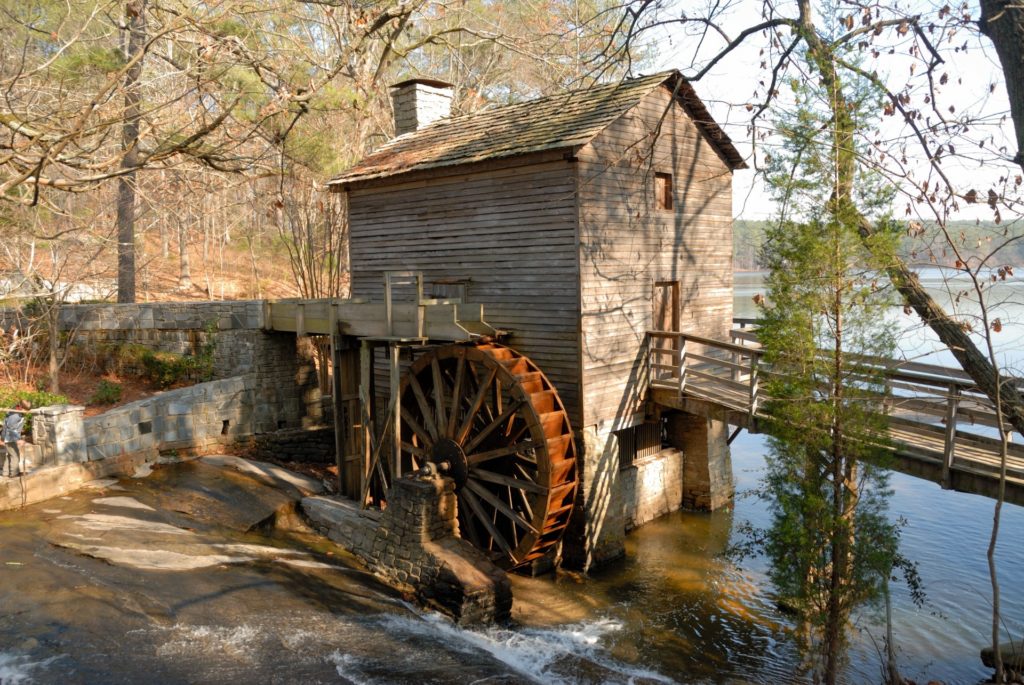
Millwright History
The millwright of the 17th and 18th centuries was quite different from the millwright of today. He was a master craftsman who completely designed and constructed mills.
Water was the only natural power source of the day, and James Watt had only just perfected the steam engine by the mid-18th century. Water was directed over hand constructed wooden mill wheels to generate power. Millwrights executed every type of engineering operation in the construction of these mills. They designed the patterns of the water wheel systems, carved the gear mechanisms, and finally erected the mill machines.
Sir William Fairbairn, a millwright of the late 19th century, wrote in his Treatise on Mills and Millwork, “…the millwright of the late centuries was an itinerant engineer and mechanic of high reputation. He could handle the axe, the hammer, and the plane with equal skill and precision…he could set out and cut in the furrows of a millstone with an accuracy equal or superior to that of the miller himself.”
The millwright of yesteryear was generally trained in arithmetic and geometry and his occupation demanded application of such principles. According to Fairbairn, his knowledge and abilities seemed unlimited. “He could calculate the velocities, strength, and power of machines, could draw in plan, and section, and could construct buildings, conduits, or watercourses, in all the forms and under all the conditions required in his professional practice…” In short, the millwright of past centuries performed the work of a civil engineer, designing and carrying out most of the mechanical operations in the United States.
The introduction of the steam engine gave freedom to industry. It created many new trades, as industry was no longer dependent on water as its sole power source, and it thereby modified the millwright’s all-encompassing role. As the means of generating power became more complex, work became more specialized. Turners, fitters, machine makers, and mechanical engineers evolved to do the work that the millwright had originally done completely by himself.
In the later part of the 19th century, iron and steel became increasingly important in the total American industrial picture as society made use of new metal machines and began to conduct its operations on a much larger scale. This too changed the traditional job of the millwright, who was accustomed to working with wood.
In 1919, James F. Hobart wrote in his book, “Millwrighting,” that “The ancient type of millwright has passed away. He has gone with the old time carpenter and obsolete shoemaker — the former with 500 pounds of molding planes and woodworking tools, the latter with nothing but pegging and sewing awls, hammer, and knife…”
The millwright no longer planned and designed the machines. His role now consisted of executing the plans produced by a designing engineer. On occasion, he would be called upon to finish and perfect the work of the designer as well as supply most of the minor engineering. He had to have a good technical education as he was responsible for calculating the strength of materials and the resultants of forces, as well as for reading drawings, understanding electricity, and building with metal. His work was now beginning to resemble the work of today’s millwright.
Millwrighting of the late 20th century through present day is an occupation which demands precision and high skill. Today’s millwright is concerned with the precision-fitting of machinery to tolerances of a thousandth of an inch. It is the millwright who installs and aligns heavy industrial machinery, including conveyor systems, escalators, electric generators, and cyclotrons, and ensures that they operate efficiently. He even puts into effect the vast and complex machines of the nuclear age.
Brotherhood Affiliation
Towards the end of the 19th century, workers were becoming increasingly aware of the need to protect their rights by unifying. As early as 1876, the millwrights of Toronto, Canada, formed unions of their craft. After the Brotherhood of Carpenters and Joiners of America had formed in 1881 and had chartered a local union in Toronto, these millwrights expressed a desire to affiliate with the Brotherhood. In 1884, they were admitted to the local there.
By the 1886 Brotherhood convention, millwrights’ affiliation with the organization had become widespread enough to effect an amendment to the General Constitution. It was officially stated that millwrights were now eligible for membership in the union. The word “millwright” was added to Article VI, Section 2, which spelled out the occupational qualifications for joining as follows: “Any stair builder, millwright, planning mill bench hand, or any cabinet maker engaged at carpenter work, or any carpenter running wood working machinery, shall be eligible to membership, if possessed of the qualifications as provided in Section I of the Article.”
Since these early formational days, millwrights have come under the jurisdiction of the Carpenters’ Union. At the turn of the century, there was a competing organization known as the Millwrights Protective Union, headquartered in Buffalo, New York. In 1920, approximately 65 millwrights held memberships with both the Millwrights Protective Union and the United Brotherhood of Carpenters and Joiners of America. The alternate Millwrights Protective Union was eventually absorbed into the Brotherhood which, since the late 1920s, has maintained complete jurisdiction over millwrighting.
Millwrighting has been an important branch of the Carpenters’ Union for the past century. This is evidenced by the fact that two millwrights have served as General Presidents of the Brotherhood since its origin; Harry Lloyd served from 1896-1898 and James Kirby from 1913-1915.
Times have really changed. The responsibilities and functions of today’s millwright have shifted as society has become more complex and industry-oriented. Over the past several hundred years, the working world has changed drastically. The millwright, in turn, has successfully adapted himself to these changes and remains an integral part of the United Brotherhood of Carpenters and of today’s working community.
-Article courtesy of Carpenter magazine, October 1979
